
Have you ever wondered how your car manages to maintain the perfect temperature, even on scorching summer days? The secret lies in a small but mighty component: the thermostat valve. This unsung hero of your vehicle’s cooling system plays a crucial role in keeping your engine running smoothly and efficiently.
Imagine driving on a hot day, only to find your car overheating unexpectedly. Or picture a chilly morning when your engine takes forever to warm up. These scenarios highlight the importance of proper temperature regulation in your car’s engine. The thermostat valve is the key player in this delicate balancing act, ensuring your engine operates at its optimal temperature range. But how exactly does this tiny device work its magic?
In this blog post, we’ll dive deep into the inner workings of the thermostat valve in your car’s cooling system. We’ll explore its operation under various conditions, the benefits it brings to your vehicle’s performance, and even tackle some common issues you might encounter. So buckle up and get ready to uncover the fascinating world of thermostat valves – your car’s temperature guardian!
Visit website: Autobiography Zone
Understanding the Thermostat Valve
Definition and purpose
A thermostat valve is a crucial component in a car’s cooling system, designed to regulate engine temperature and maintain optimal operating conditions. Its primary purpose is to control the flow of coolant between the engine and the radiator, ensuring that the engine reaches and maintains its ideal operating temperature quickly and efficiently.
The thermostat valve acts as a temperature-sensitive switch, opening and closing based on the engine’s temperature. This mechanism allows the engine to warm up quickly when cold and prevents overheating during operation. By regulating coolant flow, the thermostat valve plays a vital role in:
- Improving engine efficiency
- Reducing fuel consumption
- Minimizing emissions
- Extending engine life
- Enhancing overall vehicle performance
Location in the cooling system
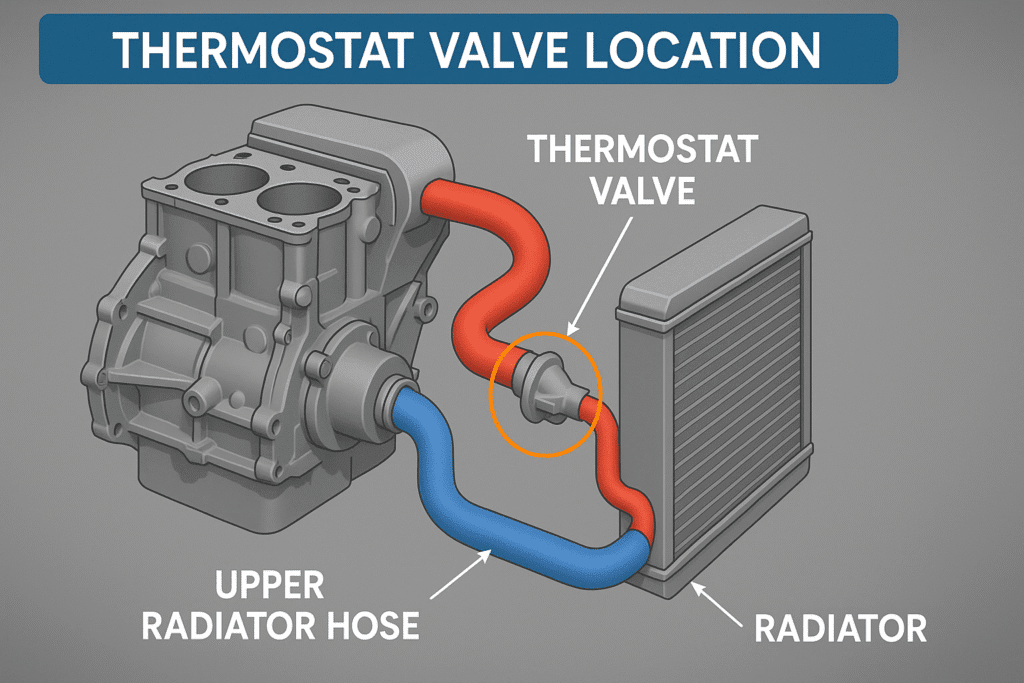
The thermostat valve is strategically positioned within the cooling system to effectively control coolant flow. Typically, it is located:
- Between the engine and the radiator
- Near the engine’s water pump
- In the upper radiator hose
This location allows the thermostat to monitor engine temperature accurately and respond quickly to changes. The following table illustrates the typical placement of a thermostat valve in relation to other cooling system components:
| Component | Location |
|---|---|
| Thermostat Valve | Between engine and radiator |
| Engine | Core of the cooling system |
| Radiator | Front of the vehicle |
| Water Pump | Near the front of the engine |
| Upper Radiator Hose | Connects radiator to engine |
| Lower Radiator Hose | Connects radiator to water pump |
Components of a thermostat valve
A thermostat valve consists of several key components that work together to regulate coolant flow. These components include:
- Valve housing: The outer casing that holds all the internal parts
- Thermostatic element: Usually a wax pellet that expands and contracts with temperature changes
- Spring: Provides resistance to keep the valve closed when the engine is cold
- Valve disc: The part that actually opens and closes to control coolant flow
- Bypass port: Allows for minimal coolant circulation when the valve is closed
- Bleed hole: A small opening that helps release air trapped in the system
The thermostatic element is the heart of the thermostat valve. As the engine warms up, the wax pellet inside the element melts and expands, pushing against the spring and opening the valve. This allows coolant to flow through the radiator for cooling. When the engine cools down, the wax contracts, and the spring closes the valve, restricting coolant flow to the radiator.
Understanding these components and their functions is crucial for diagnosing and maintaining the thermostat valve. Regular inspection and timely replacement of faulty thermostats can prevent engine overheating and ensure optimal performance of the cooling system.
Now that we’ve covered the basics of the thermostat valve, let’s explore how it regulates temperature in different driving conditions.
Visit website: Autobiography Zone
How Thermostat Valves Regulate Temperature
Opening and closing mechanism

The thermostat valve’s primary function is to regulate the engine’s temperature by controlling the flow of coolant. This is achieved through a sophisticated opening and closing mechanism that responds to temperature changes. As the engine warms up, the thermostat valve gradually opens, allowing coolant to circulate through the radiator and cool the engine. Conversely, when the engine is cold, the valve remains closed, preventing coolant flow and allowing the engine to reach its optimal operating temperature quickly.
Temperature-sensitive wax element
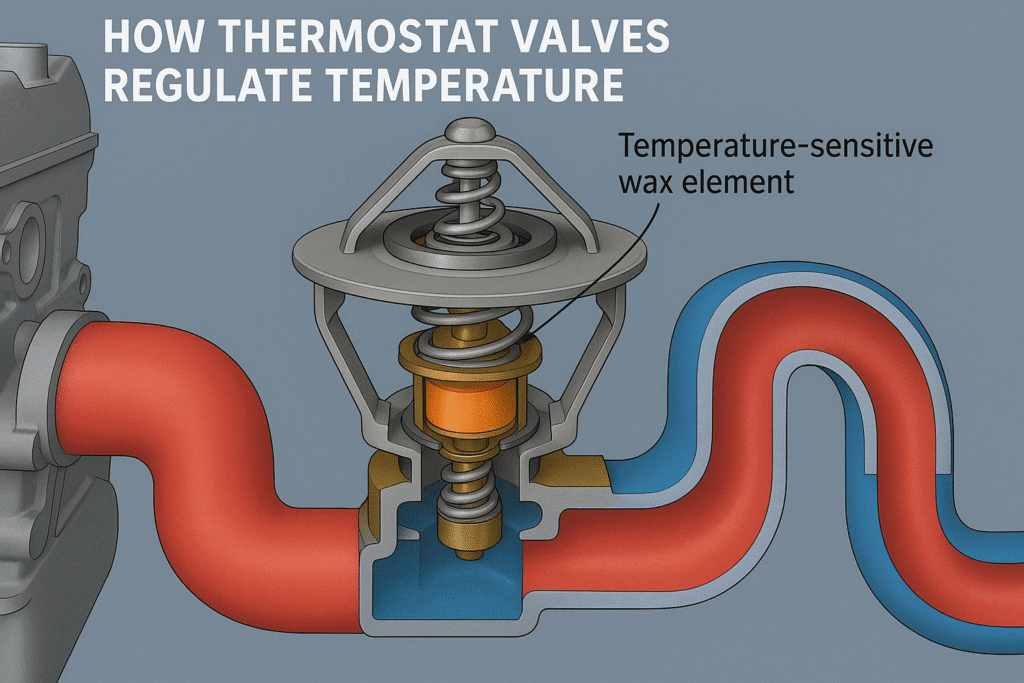
At the heart of the thermostat valve’s operation is a temperature-sensitive wax element. This ingenious component expands when heated and contracts when cooled, directly controlling the valve’s position. The wax element is carefully calibrated to respond to specific temperature thresholds, ensuring precise regulation of the engine’s cooling system.
| Temperature | Wax Element State | Valve Position |
|---|---|---|
| Cold (< 180°F) | Contracted | Closed |
| Warm (180°F – 195°F) | Expanding | Partially Open |
| Hot (> 195°F) | Fully Expanded | Fully Open |
Spring-loaded valve
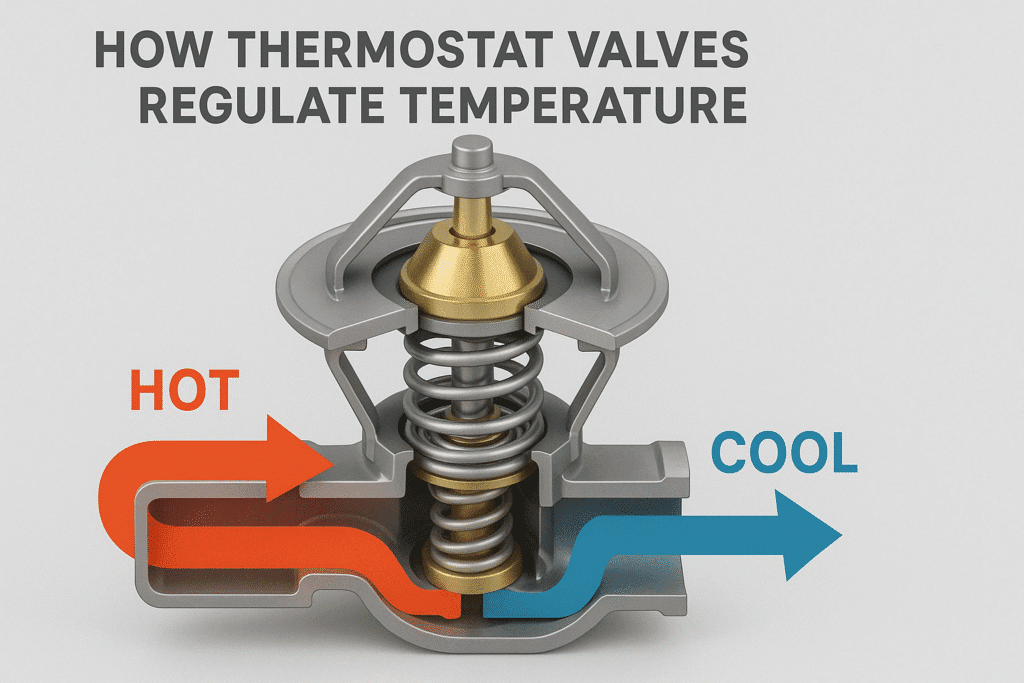
Working in tandem with the wax element is a spring-loaded valve. This component provides the necessary resistance to keep the valve closed when the engine is cold and allows for smooth, controlled opening as the temperature rises. The spring tension is carefully calibrated to balance the force exerted by the expanding wax element, ensuring a precise and responsive operation.
Key features of the spring-loaded valve include:
- Consistent pressure application
- Smooth transition between open and closed states
- Quick response to temperature changes
- Reliable operation over extended periods
Coolant flow control
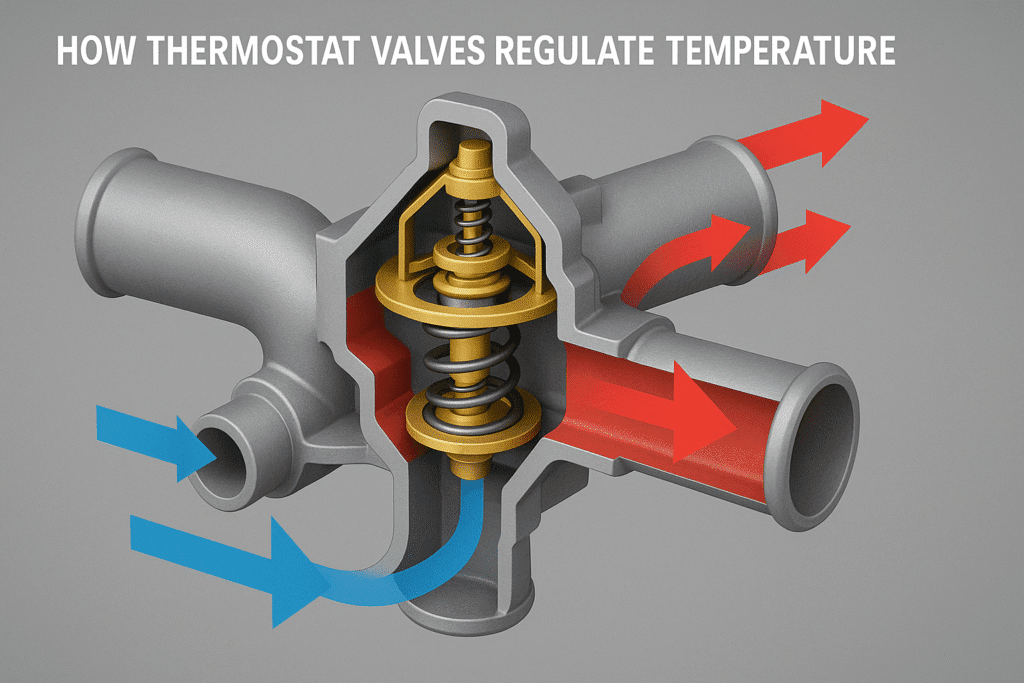
The thermostat valve’s primary role is to control the flow of coolant through the engine. This process is critical for maintaining optimal engine temperature and efficiency. Here’s how the coolant flow is managed:
- Cold engine: Valve closed, coolant circulates within the engine block
- Warming up: Valve begins to open, allowing limited coolant flow to the radiator
- Operating temperature: Valve fully open, maximum coolant flow through the radiator
- Cooling down: Valve gradually closes, reducing coolant flow as needed
This precise control of coolant flow ensures that the engine reaches its optimal operating temperature quickly and maintains it consistently, regardless of external conditions or engine load.
By effectively regulating temperature through these mechanisms, the thermostat valve plays a crucial role in optimizing engine performance, fuel efficiency, and longevity. As we’ve seen, the interplay between the temperature-sensitive wax element, spring-loaded valve, and coolant flow control creates a sophisticated system that responds dynamically to the engine’s needs. Next, we’ll explore how the thermostat valve operates under different conditions, further illustrating its importance in a car’s cooling system.
Visit website: Autobiography Zone
Thermostat Valve Operation in Different Conditions
Cold engine startup
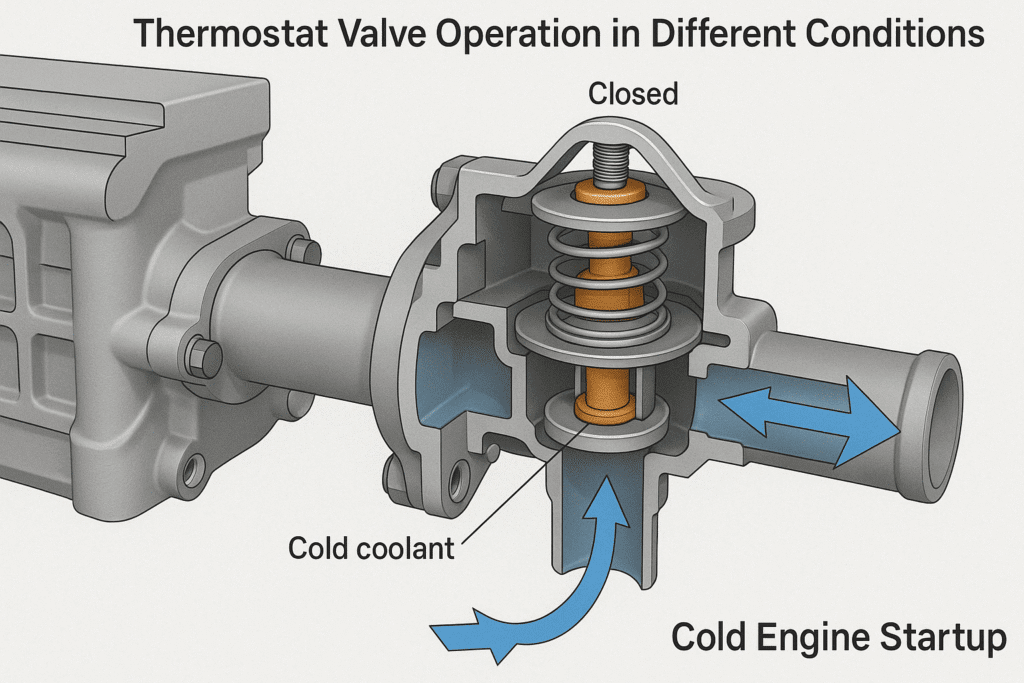
When you start your car on a cold morning, the thermostat valve plays a crucial role in warming up the engine efficiently. During this phase:
- The valve remains closed, preventing coolant circulation through the radiator.
- This closure allows the engine to warm up faster by keeping the coolant within the engine block.
- As the coolant temperature rises, it approaches the thermostat’s opening temperature (typically around 180°F or 82°C).
The closed valve during cold startup offers several benefits:
- Reduced engine wear
- Improved fuel efficiency
- Faster cabin heating for passenger comfort
| Temperature Range | Valve Position | Coolant Flow |
|---|---|---|
| Below 180°F (82°C) | Closed | Restricted to engine block |
| 180°F – 195°F (82°C – 91°C) | Partially open | Limited flow to radiator |
| Above 195°F (91°C) | Fully open | Full circulation |
Normal operating temperature
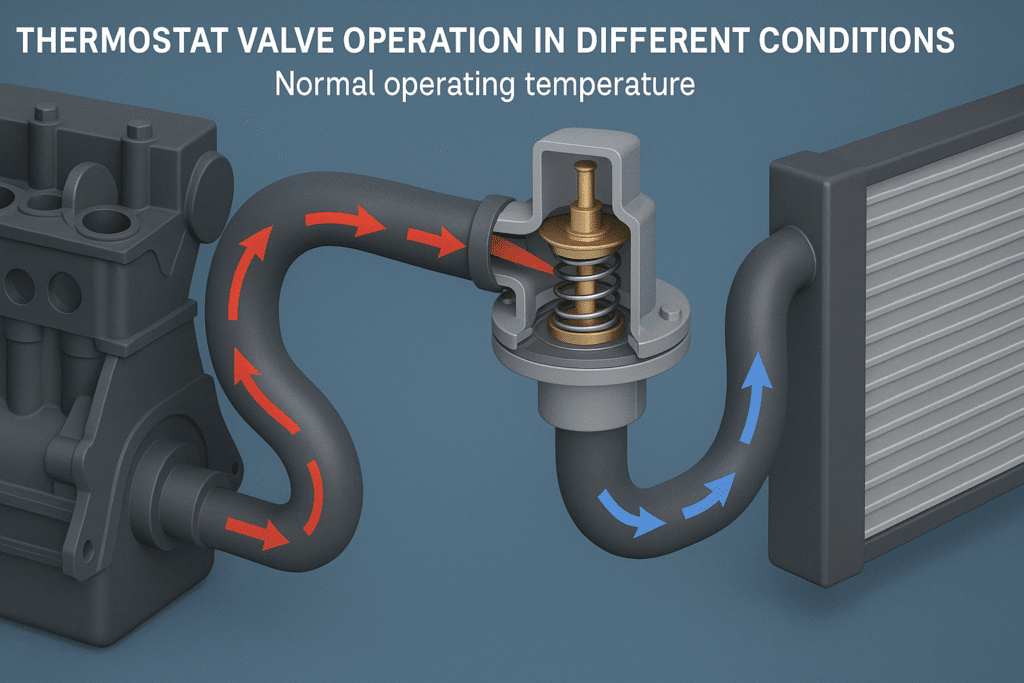
Once the engine reaches its optimal operating temperature, the thermostat valve begins to open and close as needed to maintain a consistent temperature. During this phase:
- The valve opens partially, allowing some coolant to flow through the radiator.
- It continuously adjusts its position based on temperature fluctuations.
- This dynamic operation ensures the engine stays within the ideal temperature range for maximum efficiency and performance.
Key aspects of normal operation include:
- Precise temperature control
- Balanced heat dissipation
- Optimal engine performance
- Reduced emissions
High-temperature situations
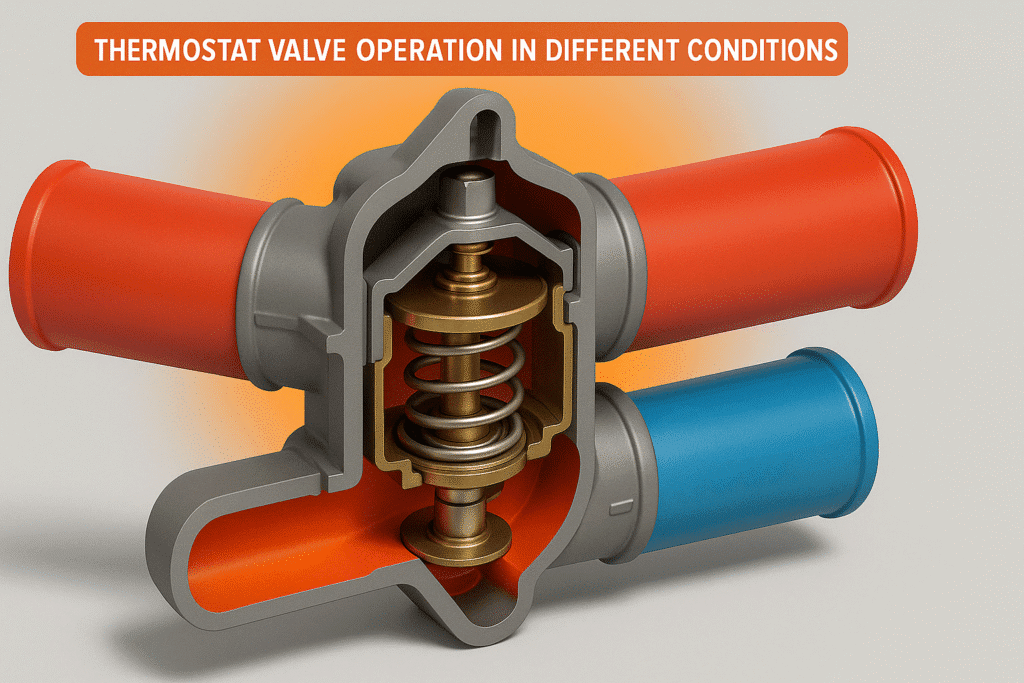
In situations where the engine temperature rises significantly, such as during hot weather or heavy engine load, the thermostat valve’s operation becomes even more critical:
- The valve opens fully to maximize coolant flow through the radiator.
- This increased flow helps dissipate excess heat more efficiently.
- The cooling system works at its maximum capacity to prevent engine overheating.
Factors that may lead to high-temperature situations:
- Climbing steep hills
- Towing heavy loads
- Driving in stop-and-go traffic
- Extremely hot ambient temperatures
During these conditions, the thermostat valve ensures:
- Rapid heat dissipation
- Protection against engine damage
- Maintained engine performance under stress
Now that we’ve explored how the thermostat valve operates in various conditions, let’s examine the overall benefits this component brings to a car’s cooling system.
Benefits of Thermostat Valves in Car Cooling Systems
Improved engine efficiency
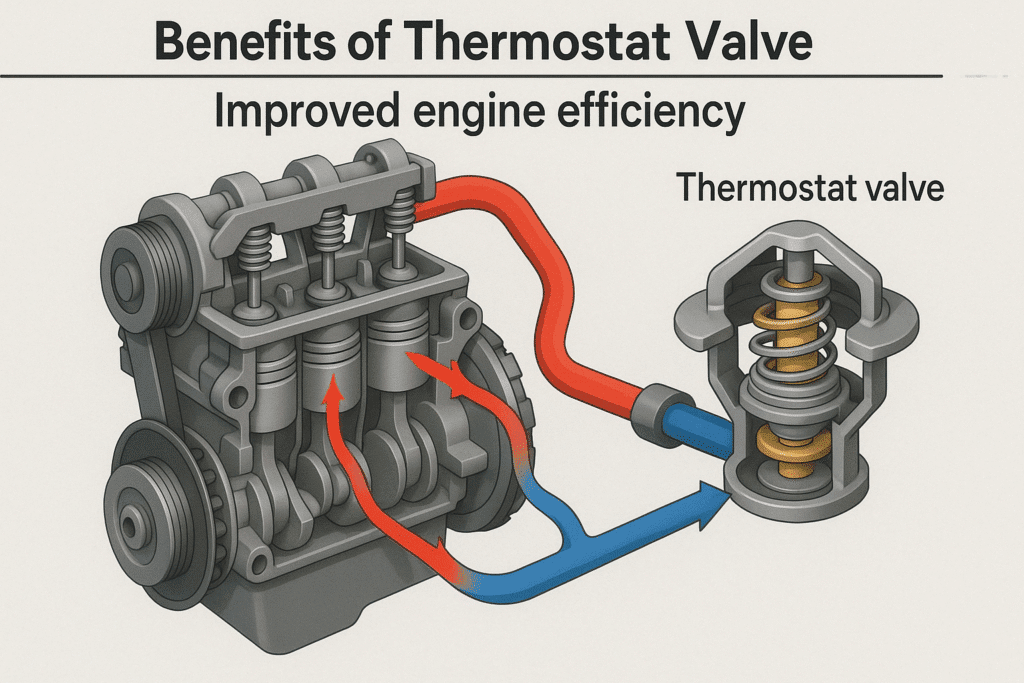
Thermostat valves play a crucial role in enhancing engine efficiency by maintaining optimal operating temperatures. By regulating coolant flow, these valves ensure that the engine reaches its ideal temperature quickly and remains within the correct range. This precise control leads to:
- Reduced friction between moving parts
- Improved combustion efficiency
- Better overall performance
A well-functioning thermostat valve can significantly impact an engine’s power output and longevity. Here’s a comparison of engine efficiency with and without a properly working thermostat valve:
| Aspect | With Thermostat Valve | Without Thermostat Valve |
|---|---|---|
| Warm-up time | Faster | Slower |
| Temperature stability | Consistent | Fluctuating |
| Fuel consumption | Lower | Higher |
| Engine wear | Reduced | Increased |
Reduced wear and tear
One of the primary benefits of thermostat valves is their ability to minimize engine wear and tear. By maintaining the ideal operating temperature, these valves help:
- Prevent thermal stress on engine components
- Reduce oil degradation
- Minimize metal fatigue
- Extend the lifespan of gaskets and seals
The consistent temperature control provided by thermostat valves ensures that engine parts are not subjected to extreme temperature fluctuations, which can cause premature wear.
Enhanced fuel economy
Thermostat valves contribute significantly to improved fuel economy in several ways:
- Optimizing engine temperature for efficient combustion
- Reducing the load on the cooling system
- Minimizing unnecessary coolant circulation
When the engine operates at its ideal temperature, it burns fuel more efficiently, resulting in better mileage and reduced emissions. This not only saves money on fuel costs but also helps vehicles meet stringent environmental standards.
Visit website: Autobiography Zone
Consistent temperature control
The ability of thermostat valves to maintain a consistent engine temperature is perhaps their most valuable benefit. This steady temperature control ensures:
- Reliable engine performance in various driving conditions
- Proper functioning of emission control systems
- Comfortable cabin heating in cold weather
- Prevention of engine overheating in hot conditions
By responding quickly to changes in coolant temperature, thermostat valves help the engine adapt to different driving scenarios, from short trips to long highway drives.
Now that we’ve explored the benefits of thermostat valves in car cooling systems, it’s important to understand the common issues that can affect their performance and how to maintain them properly.
Common Issues and Maintenance
Symptoms of a faulty thermostat valve

When a thermostat valve malfunctions, it can lead to various cooling system issues. Here are some common symptoms to watch out for:
- Fluctuating engine temperature
- Overheating
- Poor fuel economy
- Unusual coolant leaks
- Check engine light illumination
These symptoms can vary in severity and may occur individually or in combination. It’s crucial to address these issues promptly to prevent further damage to your vehicle’s engine.
Causes of thermostat failure
Several factors can contribute to thermostat valve failure:
| Cause | Description |
|---|---|
| Age and wear | Over time, the thermostat can deteriorate due to normal use |
| Contamination | Debris in the coolant can damage the thermostat |
| Corrosion | Chemical reactions in the cooling system can lead to corrosion |
| Manufacturing defects | Rare, but sometimes thermostats can be faulty from the start |
| Extreme temperatures | Prolonged exposure to very high or low temperatures can cause damage |
Understanding these causes can help you prevent issues and maintain your vehicle’s cooling system more effectively.
Replacement and repair procedures
When faced with a faulty thermostat valve, replacement is often the best course of action. Here’s a general outline of the process:
- Allow the engine to cool completely
- Drain the coolant
- Locate and remove the thermostat housing
- Replace the old thermostat with a new one
- Reassemble the housing and refill the coolant
While some car enthusiasts may tackle this job themselves, it’s often best to leave it to professional mechanics, especially if you’re unsure about the procedure.
Preventive maintenance tips
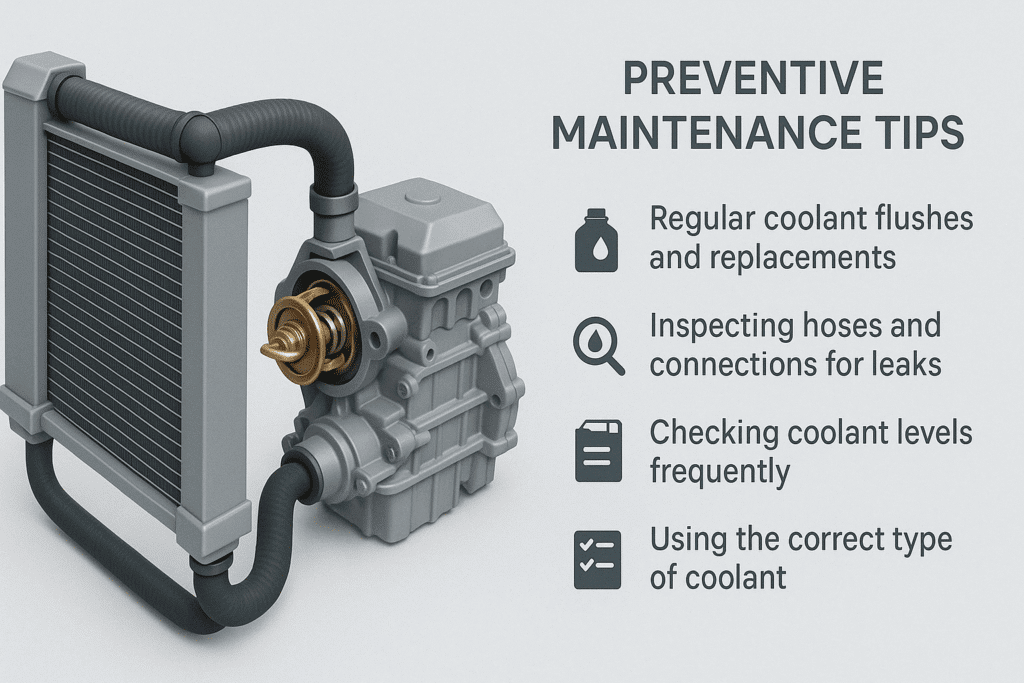
To keep your thermostat valve and cooling system in top condition, consider these maintenance tips:
- Regular coolant flushes and replacements
- Inspecting hoses and connections for leaks
- Checking coolant levels frequently
- Using the correct type of coolant for your vehicle
- Addressing any cooling system issues promptly
By following these tips, you can extend the life of your thermostat valve and maintain optimal engine performance.
Regular maintenance of your vehicle’s cooling system, including the thermostat valve, is crucial for preventing costly repairs and ensuring your car runs smoothly. While some issues may require professional attention, being aware of common problems and basic maintenance procedures can help you catch potential issues early. Remember, a well-maintained cooling system not only prevents overheating but also contributes to better fuel efficiency and overall engine health. In the next section, we’ll address some frequently asked questions about thermostat valves to further enhance your understanding of this critical component.
10 FAQs
1. What is a thermostat valve?
A thermostat valve is a crucial component of a car’s cooling system that regulates the flow of coolant between the engine and the radiator. It helps maintain the optimal operating temperature of the engine.
2. How does a thermostat valve work?
The thermostat valve operates based on temperature changes:
- When the engine is cold, it remains closed
- As the engine warms up, it gradually opens
- When fully open, it allows maximum coolant flow
3. What happens if a thermostat valve fails?
A failed thermostat valve can lead to:
- Overheating
- Poor fuel efficiency
- Increased emissions
- Engine damage
4. How often should a thermostat valve be replaced?
There’s no set replacement interval, but typically:
| Mileage | Recommendation |
|---|---|
| 50,000 – 100,000 miles | Consider inspection |
| 10 years | Replace as preventive maintenance |
5. What are the signs of a faulty thermostat valve?
Common symptoms include:
- Engine overheating
- Fluctuating temperature gauge
- Poor heater performance
- Coolant leaks near the thermostat housing
6. Can a car run without a thermostat valve?
While technically possible, it’s not recommended as it can lead to:
- Inefficient engine operation
- Increased fuel consumption
- Potential engine damage
7. How do I test if my thermostat valve is working?
A simple test involves:
- Starting the car with a cold engine
- Monitoring the temperature gauge
- Feeling the upper radiator hose for warmth after 10-15 minutes
If the hose doesn’t warm up, the thermostat may be stuck closed.
8. Are there different types of thermostat valves?
Yes, common types include:
- Traditional wax-pellet thermostats
- Electronic thermostats
- Fail-safe thermostats
9. How does climate affect thermostat valve performance?
Climate impacts thermostat operation:
| Climate | Effect |
|---|---|
| Cold | May open less frequently |
| Hot | Opens more often to prevent overheating |
10. Can I replace a thermostat valve myself?
While possible for DIY enthusiasts, it’s often best left to professionals due to:
- Need for proper tools
- Risk of coolant spillage
- Potential for air entering the cooling system
Remember, proper maintenance of your car’s thermostat valve is crucial for optimal engine performance and longevity. If you’re unsure about any issues related to your car’s cooling system, it’s always best to consult with a qualified mechanic.
The thermostat valve plays a crucial role in maintaining optimal engine temperature in your car’s cooling system. By regulating coolant flow, it ensures the engine warms up quickly and operates efficiently across various driving conditions. This small but essential component helps prevent overheating, improves fuel economy, and extends engine life.
Regular maintenance and awareness of common issues can help keep your thermostat valve functioning properly. If you notice signs of malfunction, such as fluctuating temperature gauge readings or overheating, consult a professional mechanic promptly. Understanding how your car’s thermostat valve works empowers you to better care for your vehicle and potentially avoid costly repairs down the road.
Visit website: Autobiography Zone

